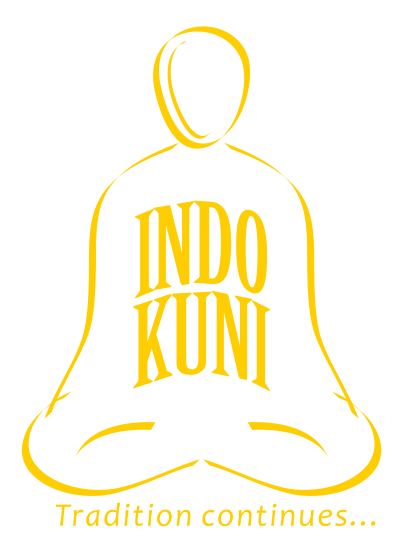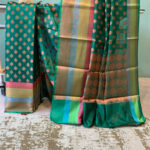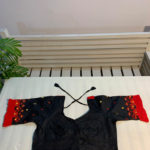The Saree Is the national dress for the Indian woman and it is a very important part of an Indian woman’s life. Most Women Adorn the Saree to Any Occasion Because 0f Its Elegance and Sophistication. The Banarasi Saree Is Not Only Popular as Part of The Bridal Wears but Women from Across the Country Love It and Wear It Also in Other Auspicious Occasion of Their Life. This Ethnic Wear Has Many Intricate and Complex Design Woven into The Six Yards That Makes the Saree Stunning. Banarasi Saree Are Produced Exclusively In The Ancient City Of Varanasi Also Known As Kashi And Surrounding Villages Utilizing Special Technicians available in various fabrics. Varanasi, a religious city and a center of wearing flourished as the capital of the Kasi Kingdom in the days when Buddha was yet alive. In Sutras9, it is mentioned that when Prince Siddharth become a bonze, he took off luxurious silk clothes of courtly taste of Kasi and wore instead earth-cikiyred robe namely kasayani vastrani. Clothes permitted to bonze in those days were made of cloths woven of waste silk fibres from wild silkworms, what was called ‘bark fibre’ cloths then, and those of hemp. There is also a story in Sutra of a person who becomes to embrace Buddhist faith by making offering to Buddha of cloths interwoven with gold threads.
Banaras is famous for its socio-economic and religious importance all over the world. The city is equally important as a brocade-weaving centre throughout the country. The weaving industry, which flourished during the Vedic period and touched its peak at the time of mogul period, explains how the act of weaving was a part and parcel of the life of the Banaras people. Whether it is the religious activity or earning of livelihood for the population, the weaving activity surpassed all other occupations. From the historical perspectives, the textile industry has found place from rig Vedic literature to post independent India. Since the Rig Vedic times, we hear about several kinds of textiles among which figures out the cloth of gold1 (the Hiranya) as a distinguished type, the god in their resplendent grandeur wear it, as they drive in their stately chariots. The Hiranya cloth has been usually interpreted as the earliest equivalent for the present day zari work or the kimkhab (brocades). We also find specific reference to the embroidery in the Vedic literature, The Jataka tales and other early Pali texts from main source of our information in that period of Indian history: we know about the weavers (tantuvidyas), their guilds and several interesting details about their technique. It is nothing strange that Banaras figures as an outstanding centre of textile manufacture in this very early stage of Indian Culture.
Banaras and its surrounding area had great cotton-growing regions; probably this spurred the textile industry in the city, which during the early period, was the capital of an important province, or sometimes of a sovereign state. Banaras is known in the pali literature as a reputed centre of textile manufacture, famous for its Kasikuttama and Kasiya. The Majjhimanikaya refers to Varaaseyyaka, known for its fine texture. The Kasika Suchivastra was probably some kind of embroidery. Kasi (old name of Banaras) continued to flourish as a regional capital under the Nandas, the Mauryas and the Sungas and we can safely ascribe to it its unbroken tradition of textile industry during those glorious periods.India as a Country with a Variety of Variations also Offers A Beautiful Curve/Range of Sarees Intrinsic from Different Communities. Banaras is one of the rich weaving craft centre of India, famous for Brocade Saris and dress material. The distinctive Look of Hand Woven Banarasi Saree Is Mainly Due to The Dual Influence of Mughal And Hindu Culture in The Textiles and The Design. In Current Technologies Dominant Era, Weavers of Banarasi Saree, Still Used Hand Weaving Techniques to Weave Intricate Design. The weaver of a Banarasi Handloom Sari is an accomplished artisan. “The skill to bring intricate patterns to life on the fabric requires lifelong commitment. He invests heavily into each piece, emotionally and financially” The quality of the handloom fabric is unmatched and a true Banarasi sari on your arm will give you goosebumps and This Is the Reason That Banarasi Sarees Makes Its Significant Impact in The Indian Fashion Industry. One unique and intricate silk brocades and sarees of Banaras has made it world famous. Some Exclusive Banarasi Saree has Intricate Design with Gold and Silver Threads an Apart from Exotic Weavings Thread That Is Zari, Resham, Silk, Cotton etc. Among the different varieties of sarees produced in the centres, some exclusive varieties of the sarees are Jangla, Tanchoi, Vaskat, Cutwork, Tissue and Butidar which are made of silk warp and silk weft, on plain/satin ground base, brocaded with extra weft patterns in different layouts introducing Buties, Bells, Creepers, Buttas in ground, border and anchal for getting glamourous appearance, which Makes It Not Just A Fashion Sense or A Glad Rag but A Thread Stitching the Emotion of Mother to Mother and Her Daughter She Will Wed-Off.
In 2009, the Banarasi sari got the GI tag. “According to the GI mandate, only the fabric made in the five districts (Varanasi, Chandauli, Bhadohi, Mirzapur and Azamgarh), by hand, using the traditional method, will be considered Banarasi. Everything else is counterfeit. So Needless to say that mostly the big cities’ showroom also buys banarasi Sarees available in various fabrics and designed from the traditional Banarasi market and further sell it at their plat form. So, keeping the “Core value of traditional Banarasi satti” we have transformed it into Virtual platform as “Digital Satti” Concept.
Indo Kuni, via this “Digital Satti” Concept Bring Forth to You Exquisite Handloom and Power Loom Banarasi Saree Collections to online platform keeping mind the safety and interest of all stake holders of banarasi saree industries including our patrons. This is not only a ray of hope to survival in such a difficult time for Banarasi saree fraternity but also an opportunity to transform the industry on digital platform upholding the uniqueness and charm of the product and the traditional way of trading through BANARASI SAREE SATTI with same dedication. In the conventional or traditional way of “Banarasi saree satti” people from different part of country would step into a shop situated in the traditional/whole sale Sarees Market of Banaras, where the weavers/ artisans assemble on facilitator request keeping buyer’s product preference, The Buyer get opportunity to see hundreds of pieces of the desired saree/ fabric directly from the weavers in this end to end trade at the facilitator shop on the basis of nominal commission/charges 1-2 % of total purchased amount, which is quite open and transparent as the commission/facilitation charges clearly mentioned on the invoice which facilitator issue to buyer based on his purchasing. In lieu of that buyer get Guarantee of Genuine product and Guarantee of Reasonable Pricing which is generally hard to get in big and high-end showrooms where the maintenance and staff expenses usually quite high compared to a Traditional market shop.
Conclusion
By this endeavor we are happy to fulfill our patron’s requirement of buying a genuine Banarasi product, by connecting them directly with the Weaver/Artisan and facilitate in purchasing of their desired Banarasi Sarees available in various fabrics i.e. Silk, Cotton, Chiffon, Tussar-Silk, Cora-Silk, Georgette, Organza, Satin-Silk, Semi- Silk, Matka-Silk, Chiniya-Silk, Dupion-Silk, Muga-Silk, Katan-Silk etc & various unique Designs/Patterns such as, Tanchoi, Jamawar, Jamdani, Kim khab, Patola, Bel-Butti, Paithini, Jagla, Kaduta Bel-Butti, Tissue, Plain Aanchal Border, Neelambari, Ikat and many more.
Jai Hind




